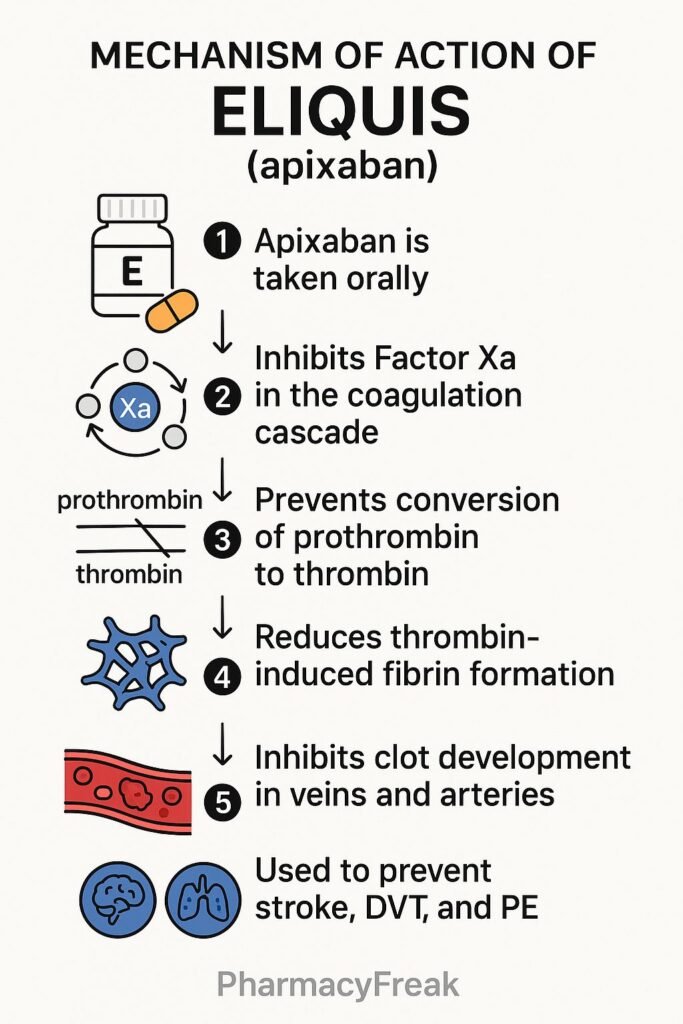Table of Contents
Introduction
Eliquis (apixaban) is an oral direct Factor Xa inhibitor used to prevent stroke in nonvalvular atrial fibrillation and to treat or prevent deep vein thrombosis (DVT) and pulmonary embolism (PE). It binds selectively and reversibly to both free and clot-bound Factor Xa, blocking thrombin generation and fibrin clot formation without needing antithrombin III.
Step-by-Step Mechanism of Action
- Selective Factor Xa Inhibition
Apixaban directly inhibits both free and fibrin-bound Factor Xa. - Blockade of Thrombin Generation
By inhibiting Factor Xa, it prevents the conversion of prothrombin to thrombin. - Reduced Fibrin Formation
Lower thrombin levels result in decreased fibrin production and clot stabilization. - Indirect Antiplatelet Effect
Reduced thrombin activity minimizes platelet activation and aggregation. - Reversible and Predictable Response
Its reversible binding and predictable pharmacokinetics allow consistent dosing with minimal monitoring.

Pharmacokinetic Parameters
| Parameter | Value |
|---|---|
| Bioavailability | ~50% |
| Volume of Distribution | Approximately 21 L |
| Protein Binding | ~87–94% |
| Metabolism | Hepatic via CYP3A4 (major), CYP1A2, CYP2C8/9/19 (minor) |
| Half-Life | ~12 hours |
| Excretion | ~75% fecal, ~25% renal |
Clinical Uses
- Prevention of stroke and systemic embolism in nonvalvular atrial fibrillation
- Treatment and prevention of DVT and PE
- Prophylaxis of DVT following hip or knee replacement surgery
Adverse Effects
- Bleeding (e.g., gastrointestinal, intracranial)
- Anemia
- Bruising
- Rare: elevated liver enzymes, hypersensitivity reactions
Comparative Analysis
| Feature | Apixaban (Eliquis) | Warfarin |
|---|---|---|
| Monitoring | Not required routinely | Requires INR monitoring |
| Onset of Action | Rapid (~2–4 hours) | Slow (several days) |
| Food and Drug Interactions | Minimal | Numerous |
| Reversibility | Partial (andexanet alfa) | Full (vitamin K, PCCs) |
| Risk of Intracranial Bleed | Lower | Higher |
MCQs
1. What is the mechanism of Eliquis?
A. Thrombin inhibitor
B. Vitamin K antagonist
C. Factor Xa inhibitor
D. Platelet P2Y₁₂ antagonist
Answer: C
2. Apixaban prevents conversion of which factor?
A. Fibrinogen→Fibrin
B. Prothrombin→Thrombin
C. Prothrombin→Thrombin
D. Thromboxane A₂ synthesis
Answer: C
3. Monitoring INR is required with Eliquis.
A. True
B. False
Answer: B
4. Apixaban metabolism involves which enzyme?
A. CYP2D6
B. CYP3A4
C. CYP2C19
D. CYP1A2
Answer: B
5. Half-life of apixaban is approximately:
A. 6 h
B. 12 h
C. 24 h
D. 48 h
Answer: B
6. Major route of elimination is via:
A. Renal only
B. Hepatic only
C. Fecal and renal
D. Pulmonary
Answer: C
7. Compared to warfarin, apixaban has:
A. More drug interactions
B. Requires INR monitoring
C. Lower intracranial bleeding risk
D. Slower onset
Answer: C
8. Eliquis requires antithrombin III to work.
A. True
B. False
Answer: B
9. Use of andexanet alfa is associated with apixaban as:
A. Alternative therapy
B. Reversal agent
C. Prodrug
D. Antiplatelet booster
Answer: B
10. Apixaban’s binding to Factor Xa is:
A. Irreversible
B. Allosteric
C. Reversible
D. Cofactor-dependent
Answer: C
FAQs
1. Does Eliquis require routine blood monitoring?
No—regular INR checks are not needed.
2. Is Eliquis reversible?
Yes—a specific reversal agent called andexanet alfa is available for serious bleeding.
3. Can Eliquis be used in mild kidney disease?
Yes—but dose adjustments are required in moderate to severe renal impairment.
4. Does food intake affect absorption?
No significant impact; can be taken with or without food.
5. Is Eliquis safe during pregnancy?
Limited data—generally avoided unless benefits outweigh risks.
References
- DrugBank – Apixaban Pharmacology & MOA
- NCBI PMC – Apixaban Clinical Pharmacology Review
- FDA Label – Eliquis (Apixaban)
- Stroke Manual – Apixaban Overview
- Wikipedia – Direct Factor Xa Inhibitors
Related Links

I am pursuing MBA in pharmaceutical management from NIPER Hyderabad with a strong academic record and proven success in national-level pharmacy entrance exams. I secured AIR 61 in NIPER 2024 (MS/M.Pharm) and AIR 27 in NIPER MBA, along with AIR 147 in GPAT 2024 and AIR 907 in GPAT 2023. I also achieved AIR 6 in AIIMS CRE-2025 for Drug Store Keeper and was selected as a Pharmacist (AIR 61) for ESIC. Additionally, I was the Runner-Up in Round 2 of the EY Case Study Competition.
At PharmacyFreak.com, I aim to guide future pharmacists through expert content, exam strategies, and insightful resources based on real experience and academic excellence.
Mail- harsh@pharmacyfreak.com
